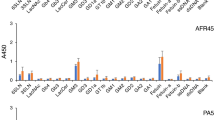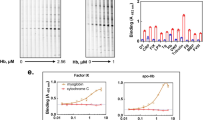Abstract
AT low ionic strength the rate of association of certain antibodies with their corresponding antigens is increased (for review see ref. 1) and the detection of human blood group antibodies may be facilitated2,3. In the course of testing sera which had been ‘de-ionized’ either by passage through ‘Sephadex G-50’ columns or by dialysis against a sucrose–saline solution of ionic strength 0.025, it was observed that the sera were giving ‘false positive’ reactions; that is to say, if red cells were incubated with their own ‘de-ionized’ serum at I = 0.025, then washed and mixed with anti-human globulin serum, agglutination occurred. The red cells were only very weakly agglutinated by specific anti-7S γ-globulin sera but were strongly agglutinated by anti-β1E-globulin serum and less strongly by anti-β1C-globulin serum; thus the complement components C′4 and C′3a were both present on the red cells4. Positive results were also obtained with an immunoconglutinin serum (‘auto-stimulation’ type5). As expected, the addition of EDTA to the serum before incubation with red cells prevented the uptake of complement.
This is a preview of subscription content, access via your institution
Access options
Subscribe to this journal
Receive 51 print issues and online access
$199.00 per year
only $3.90 per issue
Buy this article
- Purchase on Springer Link
- Instant access to full article PDF
Prices may be subject to local taxes which are calculated during checkout
Similar content being viewed by others
References
Hughes-Jones, N. C., Brit. Med. Bull., 19, 171 (1963).
Hughes-Jones, N. C., Polley, M. J., Telford, R., Gardner, B., and Klein-schmidt, G., Vox Sang., 9 (in the press, 1964).
Elliot, M., Bossom, E., Dupuy, M. E., and Masouredis, S. P., Vox Sang., 9 (in the press, 1964).
Harboe, M., Müller-Eberhard, H. J., Fudenberg, H., Polley, Margaret J., and Mollison, P. L., Immunol., 6, 412 (1963).
Coombs, Ann, and Coombs, R. R. A., J. Hyg. (Lond.), 51, 509 (1953).
Rapp, H. J., and Borsos, T., J. Immunol., 91, 826 (1963).
Author information
Authors and Affiliations
Rights and permissions
About this article
Cite this article
MOLLISON, P., POLLEY, M. Uptake of γ-Globulin and Complement by Red Cells exposed to Serum at Low Ionic Strength. Nature 203, 535–536 (1964). https://doi.org/10.1038/203535a0
Issue Date:
DOI: https://doi.org/10.1038/203535a0
This article is cited by
-
Detection of red cell sensitisation by antibody and complement: Current practice and future perspectives
Comparative Haematology International (1993)
-
Localisation of Chido and Rodgers determinants to the C4d fragment of human C4
Nature (1978)
-
Capacity of complement C3 phenotypes to bind on to mononuclear cells in man
Nature (1974)
-
Ein Hämagglutinationstest zum Nachweis von Lysozym
Blut Zeitschrift für die Gesamte Blutforschung (1966)
Comments
By submitting a comment you agree to abide by our Terms and Community Guidelines. If you find something abusive or that does not comply with our terms or guidelines please flag it as inappropriate.



